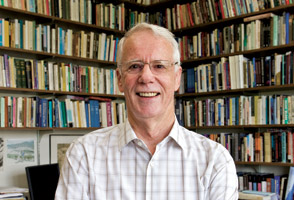Pitt World History Center Academic Alliance to Determine Most Meaningful Way to Teach Global History
 What is the best way to teach the daunting subject of world history? Are high school teachers expected to cover the Old Stone Age up to the present in one academic year? And how can we upgrade the skills of today’s high school history teachers?
What is the best way to teach the daunting subject of world history? Are high school teachers expected to cover the Old Stone Age up to the present in one academic year? And how can we upgrade the skills of today’s high school history teachers?
The desire to answer those types of questions forms the basis of the new Alliance for Curriculum and Professional Development in World History, which was established this month by Pitt’s World History Center (WHC), part of the Department of History in the Kenneth P. Dietrich School of Arts and Sciences.
In addition to including Pitt faculty members from the WHC, the alliance also will be led by experts from the National Center for History in the Schools at UCLA and from the Department of History at California State University, Long Beach. In all, the alliance will draw upon expertise from about 20 scholars from those three institutions.
“Of the five world history grants awarded by the Social Science Research Council, ours is distinctive in that it sets up a national network for professional development for teachers of world history,” said Patrick Manning, Andrew W. Mellon Professor of World History at Pitt and the WHC’s director.
While many secondary school teachers are prepared to teach U.S. history and European history, Manning said they may be ill equipped to teach world history. “Teaching world history is more than learning about who is our enemy and who is our friend,” he said, adding that a country-by-country approach doesn’t work, either. The aim of a world history course, he said, is to investigate the interactions of the pieces in human history—whether those pieces are communities, societies, or continents—and to assess the experience of humanity as a whole through the study of those interactions.
“It should be about interactions among peoples and places, not a series of separate stories. It has to be interpretive,” he added.
The Alliance for Curriculum and Professional Development in World History has organized the first of two conferences—one scheduled at UCLA Nov. 9-10 and the second at Pitt, May 31-June 1, 2013. Leading world history teachers, academic researchers, and representatives from professional organizations will convene and use the online resource World History For Us All (http://worldhistoryforusall.sdsu.edu) as a framework to draft an innovative world history curriculum and design a professional development course for teachers. Conference participants will hear updates on the latest research in pedagogy and student learning, as it applies to history courses. Experts in England, for example, have been doing pioneering work on what happens cognitively to students while they learn history.
Such international connections are important for the alliance. Manning envisions that the partnership will eventually establish an international network to advance world history education. The WHC already works with historians on every continent and has been doing so since the center’s founding at Pitt in 2008.
Once the alliance constructs a curriculum and professional development workshops, it will put the curricular materials—from global narratives and geographic links to big implications of small events—it develops online and encourage teachers and school districts around the globe to use them at their own workshops.
“As teachers develop tools for conveying world history’s emphasis on connections and interactions between people and places, students will benefit from this broad approach,” said Molly Warsh, a new assistant professor of world history at Pitt and one of the discussion leaders at the upcoming UCLA conference.
“If students leave the classroom prepared to think critically about how history is made and told on a world scale, that will be quite an accomplishment,” said Warsh.
Manning agrees, calling the study of world history “a nice rehearsal for students for dealing with the real world.”
Other Stories From This Issue
On the Freedom Road

Follow a group of Pitt students on the Returning to the Roots of Civil Rights bus tour, a nine-day, 2,300-mile journey crisscrossing five states.
Day 1: The Awakening
Day 2: Deep Impressions
Day 3: Music, Montgomery, and More
Day 4: Looking Back, Looking Forward
Day 5: Learning to Remember
Day 6: The Mountaintop
Day 7: Slavery and Beyond
Day 8: Lessons to Bring Home
Day 9: Final Lessons

